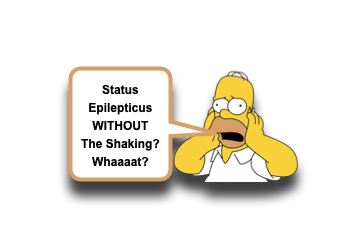Non-Convulsive Status Epilepticus

Most chief complaints generate a clear Differential Diagnosis (Ddx) list in your mind. There are the well-known, “big ticket” issues that need to be considered (Abdominal Pain -> Appendicitis; Chest Pain -> Pericarditis; Headache -> Meningitis) as well as the more common causes (Abdominal Pain -> CRAP; Chest Pain -> Asthma; Headache -> Benign Headaches). The challenge with children, as we have stated numerous times, is that the significant problems can masquerade as benign ones. Additionally, their non-specific presentations overlap greatly, requiring us to be ever vigilant. One presentation that requires a very broad Ddx list is Altered Mental Status. Let us take a minute to highlight one item on that Ddx list that may be overlooked – Non-Convulsive Status Epilepticus in Children:
Non-Convulsive Status Epilepticus
- My simple definition: Non-Convulsive Status Epilepticus (SE) = an electrical storm in the brain, but there is no shaking on the outside.
- It is like the Pulseless Electrical Activity of the brain… there is electrical activity, but no muscular movement.
- Both are bad!
- The actual definition is more complicated … [Jafarpour, 2015; Wilson, 2015; Abend, 2009]
- “Electromechanical uncoupling, when electrical seizure activity persists despite resolution of the clinical manifestations.” [Wilson, 2015] (I like that one)
- “Nearly continuous electrographic seizures without convulsive activity, manifesting as: [Abend, 2009]
- Altered Mental Status or
- Coma
- Various definitions also include: [Jafarpour, 2015; Abend, 2009]
- 3 Criteria:
- Cognitive deficits
- Evidence of subconical seizures on EEG
- Improvement after suppression/remission of seizures
- Duration?? Kinda depends…
- Definition varies based on year of study…
- Prior to 2012, Status Epilepticus required at least 30 min of seizure / not returning to baseline.
- In 2012, Status Epilepticus definition changed to include seizure activity lasting > 5 min (although, adverse outcomes still associated with 30 min threshold.
- In reality, we are not going to diagnose Non-convulsive SE after only 5 min of altered mental status… but, considering it early will hopefully help get the EEG ordered sooner!
- 3 Criteria:
- It is NOT Rare! [Abend, 2009]
- It is common in ALL inpatient settings, not just the PICU. [Greiner, 2012]
- Estimates vary (based on the definition used).
- Incidence as high as 46% of critically ill children.
- In children with clinical suspicion for non-convulsive SE, 14% found to have it. [Greiner, 2012]
- It is often under-diagnosed / under-recognized [Greiner, 2012; Tay, 2006]
- It is difficult to diagnose as it may be confused with behavioral change.
- 23 – 34% of cases who had EEG monitoring for altered mental status in the ED had non-convulsive SE! [Abend, 2009]
- It is common in ALL inpatient settings, not just the PICU. [Greiner, 2012]
- It does have consequences! [Jafarpour, 2015; Abend, 2009]
- Non-convulsive SE has been associated with:
- Higher mortality
- Longer PICU stays
- Greater short term disability
- Greater long term disability
- Morbidity and Mortality often predicated upon underlying condition… but non-convulsive SE can occur in absence of acute etiology. [Jafarpour, 2015; Greiner, 2012]
- Non-convulsive SE has been associated with:
- Continuous EEG is required to make the diagnosis! [Wilson, 2015]
- The lack of external seizure activity makes this challenging to detect.
- There may be subtle “twitching” or “abnormal eye movement.”
- May also present as: [Yamaguchi, 2019]
- Agitation
- Lethargy
- Delirium
- Abnormal Movements
- Prolonged Altered Consciousness
- Ultimately, the diagnosis is dependent upon the EEG findings.
- Prompt recognition is important to be able to improve outcomes. [Yamaguchi, 2019; Greiner, 2012; Tay, 2006]
- Initiation of EEG is often delayed…
- Hard to recognize need.
- Hard to coordinate STAT EEG.
- Reduced-lead (4 channel) EEG or EEG “cap” has been successful at detecting seizure activity within 1 hour! [Yamaguchi, 2019; Jafarpour, 2015; Greiner, 2012; Abend, 2009]
- Early EEG (even in the ED) can help pick up on the diagnosis early and affect therapy.
- ~50% of non-convulsive SE can be seen in first hour.
- 80-87% detected within 24 hours of continuous EEG monitoring.
- Initiation of EEG is often delayed…
- The lack of external seizure activity makes this challenging to detect.
Non-Convulsive Status Epilepticus: When To Consider
- High Risk for Non-Convulsive SE [Wilson, 2015; Jafarpour, 2015; Greiner, 2012]
- Acute Encephalopathy
- Known abnormal brain anatomy
- CNS infection
- Cerebral edema
- Hypoxic insult (ex, post arrest)
- Status Epilepticus or Refractory Status Epilepticus [Tay, 2006]
- Just because you successfully resolved the external shaking, doesn’t mean the brain is still not in a chaotic electrical storm.
- Certainly, if you intubated the patient, then the paralytic will create “non-convulsive SE.”
- Acute Encephalopathy
- Other considerations for Non-Convulsive SE [Wilson, 2015; Greiner, 2012]
- Underlying Epilepsy Diagnosis
- Younger Age (< 24 months of age)
- Underlying Congenital Heart Disease
- Use of a Reduced-Lead EEG (only 4 electrodes) has been shown to help expedite detection of non-convulsive SE while patient is still in the ED. [Yamaguchi, 2019]
Moral of the Morsel
- Altered Mental Status does not just equal “CT / LP.” Consider the broad Ddx. TIPS AEIOU!
- Acting oddly… it may be the chaotic brain-storm! Add non-convulsive status epilepticus to the Ddx of altered mental status.
- EEG early can help! It may not be easy to get… all the more reason to start that process early!

